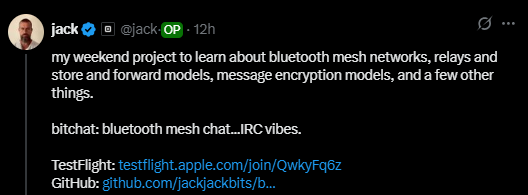Jack Dorsey’s Bitchat App Defies the Grid: Send Messages Without Internet in 2025
Twitter founder Jack Dorsey drops a connectivity bombshell—Bitchat bypasses ISPs entirely, letting users communicate offline via mesh networks. No more carrier fees, no more censorship chokeholds—just peer-to-peer whispers in the digital dark.
How it works: The app piggybacks on Bluetooth and local WiFi to create ad-hoc networks, turning every phone into a mini-tower. Messages hop between devices until they hit their target—no centralized server, no government kill switch.
Why it matters: While Wall Street still struggles with blockchain use cases beyond monkey JPEGs, Dorsey’s solving actual infrastructure problems. Bitchat could be the first step toward a parallel internet—one that doesn’t care about your credit score or browsing history.
The catch? Early tests show latency comparable to 1998 dial-up. But when the next internet blackout hits—whether from solar flares or authoritarian regimes—this might be the only app still standing.

Key Insights:
- Jack Dorsey launches Bitchat beta for decentralized Bluetooth mesh messaging
- App operates without internet using Bluetooth Low Energy mesh networks
- Messages remain ephemeral with end-to-end encryption and automatic relay
Block CEO Jack Dorsey unveiled Bitchat beta, a decentralized messaging app operating over Bluetooth networks. The peer-to-peer system functions without internet infrastructure using Bluetooth Low Energy mesh technology.
Messages remain encrypted and ephemeral while automatically relaying across connected devices. Dorsey developed the weekend project to explore Bluetooth mesh networking and encryption models for resilient communication.
Bluetooth Mesh Architecture Powers Decentralized Communication
Bitchat operates through a custom mesh networking protocol built on Bluetooth Low Energy technology.
Each device functions simultaneously as both central client and peripheral server. This dual role creates automatic multi-hop message delivery across connected devices.
The system forms local clusters based on physical proximity within 30-meter Bluetooth ranges. Bridge nodes connect separate clusters when devices overlap between different groups. Messages hop across the entire network to reach distant peers automatically.

No infrastructure requirements exist as the system runs completely peer-to-peer.
Each device that joins advertises itself as a BLE peripheral with the bitchat UUID service. The devices continually scan for other devices advertising the same service identifier.
Connection management handles a number of technical problems inside Bluetooth Low Energy boundaries. The system maintains battery life through duty cycling while maintaining the network alive. Peer tracking maintains active device lists with signal strength measurements.
Automatic reconnection methods recover from lost connections gracefully without any manual interaction.
The mesh network manages BLE connection limits through smart connection distribution. Devices can handle multiple connections in central and peripheral modes.
The relay protocol extends messaging beyond direct Bluetooth communication range. Multi-hop forwarding enables messages to be delivered to peers via intermediate device connections. The architecture builds robust communication networks in regions with no conventional internet infrastructure.
Message Relay and Privacy Features Ensure Secure Communication
Bitchat uses automatic caching of messages if receivers are out of reach over direct links. The system buffers messages temporarily until target devices come back online to the mesh network.
Regular peer messages receive 12-hour retention whereas favorite peer messages cache indefinitely.
Delivery is also done automatically upon previously out-of-range peers coming back into range of the network. Message IDs prevent duplicate delivery over multiple relay hops across the mesh. This prevents spam as well as bandwidth consumption on attached devices.
End-to-end encryption protects all private messages between users on the platform. No phone numbers, email addresses, or permanent identifiers are required for account creation. Messages exist only in device memory by default without server storage.
The fleeting nature implies communications vanish upon delivery with no lasting records.
Privacy features protect user identities without reducing messaging capability. No central servers store user data or communication history.
Tiered retention policies weigh functionality against the privacy protection among varying user relationships. Connection limits are managed automatically within the Bluetooth Low Energy technical limitations.
Peer tracking provides real-time lists of devices and signal strength measurements for best routing. Disconnections are managed by automatic reconnection without any manual user intervention or reconfiguration.
Use Cases Target Infrastructure-Independent Communication Scenarios
Bitchat addresses multiple scenarios where traditional internet-based messaging fails or faces restrictions. Conference attendees can communicate directly without relying on venue WiFi networks. The system works effectively in crowded environments where cellular networks become congested.
Protest situations benefit from decentralized communication that avoids government monitoring or internet shutdowns.
Activists can coordinate activities through mesh networks that operate independently from state-controlled infrastructure. The system provides censorship-resistant communication during civil demonstrations.
Disaster areas lose their internet connection when the infrastructure is destroyed by natural accidents. The residents and emergency responders can remain connected through Bluetooth mesh networks. The system continues to function when the cellular towers and internet lines are disrupted.
Remote locations lacking reliable internet access can establish local communication networks. Rural communities can connect devices without depending on distant cellular infrastructure. The mesh network creates local connectivity zones for immediate area communication.
Dorsey developed Bitchat as a weekend project to explore Bluetooth mesh networking concepts. He co-founded Twitter while also founding decentralized social platform Bluesky in 2019. His departure from the Bluesky board occurred in May 2024 without public explanation.

